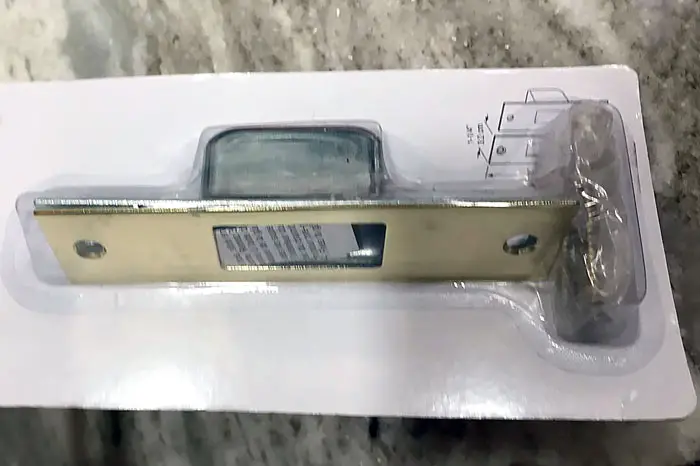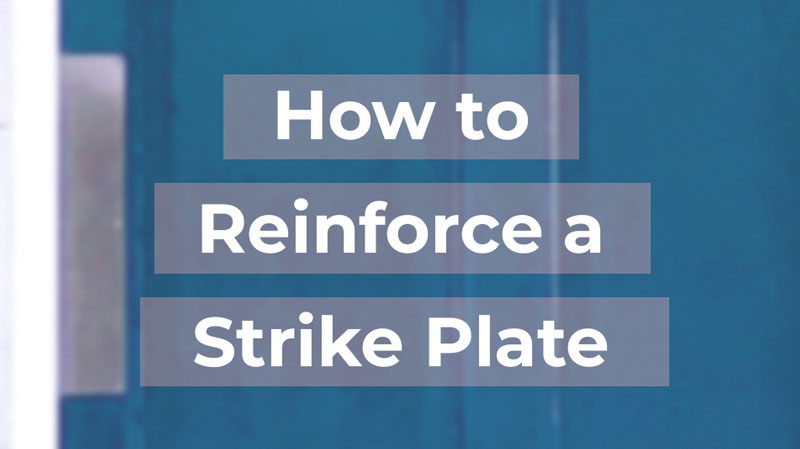When it comes to home security, strike plates play an essential role: they keep the door securely closed.
A strike plate is a small plate made of metal that’s mounted on the jamb over a mortise. The door bolt or latch extends into this hole when the door is closed.
No matter how secure the deadbolt you install or how strong your door is, a weak strike plate will make all your efforts futile.
By upgrading and reinforcing your door strike, you can reduce the risk of forced entries.
Let’s see how you can do that the right way.
1. How to Reinforce Your Existing Strike Plate
If you need a quick fix on a budget, the most obvious step is to reinforce your existing door strike.
A simple way to upgrade a strike plate is to replace the old screws with longer and more robust ones which provide more holding power. This way the strike will withstand greater forces.
Here’s how you can do it:
- Get hardened steel screws that are at least 3 inches long. Stainless steel material is especially important for exterior doors to prevent corrosion.
- Make sure the diameter of the screws is a good fit for the material of the door frame. Screws with a larger diameter are usually more secure, however, too thick screws may cause the door jamb to split.
- Remove the existing screws
- Make sure the strike plate is aligned with the existing holes and secure it with the new, longer screws
To prevent the strike plate from sliding out of its original position, replace one screw at a time.
Again, strike plate screws should be at least 3 inches long if your goal is to increase the level of security.
Tip
For extra security, make sure you use screws that you can drive deep into the stud next to the door frame. Most door frames have a width of about 1 inch, that’s why screws with a 3 inches length are a good choice in most cases. Sometimes you might need even longer screws to reinforce your strike plate.
Benefits of this method:
- It costs only a few bucks and can be done in a minute
- Longer screws allow the strike plate to withstand a greater lateral force
- Anchoring the strike plate to a stud right next to the door frame provides additional support and makes it more difficult for an intruder to kick the door open
The drawback is that even though your strike plate is now securely attached to the jamb, you’re still heavily relying on the strength of the door frame. Therefore, if the frame is made of weak material or shows signs of wear, such as splits or cracks, reinforcing it is highly recommended.
2. Replacing Your Existing Strike Plate With a Heavy-Duty Model
You can take the previous method one step further by replacing the whole strike plate with a heavy-duty model that’s designed for improved security.
What are the criteria for choosing a heavy-duty security strike plate?
- Opt for a robust model that’s made of high-quality steel, which is less likely to break under stress
- Make sure it has a thickness of at least ⅓ inches
- Reinforced corners further improve sturdiness
- It must be a solid product consisting of a single piece
- It should come with long screws (at least 3 inches); if it doesn’t, you must buy them separately
Obviously, you also want to make sure it has the right dimensions for the mortise and door jamb and it’s compatible with the existing locking system. It’s a good practice to measure the dimensions of your old strike plate before buying.
You may need to adjust the size of the mortise to the new strike. In most cases, you can do the job using a chisel and a hammer.
A good example of a hardened door strike is a box strike plate. It’s a type of security strike plate that comes with a steel cup that’s inserted into the hole in the jamb. This box receives and encloses the deadbolt when you lock the door.
The main advantage of a box strike plate over a standard strike plate is that when you lock the door, the bolt extends into a steel cup which provides extra security for your exterior door. So instead of a relatively thin piece of metal and wood, the deadbolt is surrounded by stainless steel, which is much more resistant to force attacks.
Here’s what it looks like:

When buying, make sure the box has the proper depth for the mortise and deadbolt.
Security lip strike plate is another reliable type. It’s secured to the door jamb with usually 6 long screws. It partially protects the jamb as well which reduces the likelihood of successful tampering.
You can also choose a double strike plate, which has openings for both the latch and the bolt. It’s usually thicker and more robust than a standard strike plate.
3. Use a Door Reinforcement Kit
Although this method requires more investment than the previous ones, it can really take door security to the next level.
A high-quality door reinforcement kit provides a higher level of security than a single hardened strike plate. It not only makes your strike plate stronger but also improves the overall resistance of your door.
A door security kit typically consists of the following components:
- security strike plate
- jamb shield
- hinge shield
Some kits may contain additional pieces of hardware, such as an anti-pry plate.
The main advantage of a door reinforcement kit is the holistic approach. The individual components help you reinforce some of the weakest parts of your door: the strike plate and the hinges. Also, most kits will protect against prying, kick-ins, and other high-force attacks.
Door Armor from Armor Concepts is a good example of a high-quality security kit but there are many other products to choose from.
Installing a door reinforcement kit usually does not require a professional. So in most cases, it shouldn’t cause any problem for anyone who has at least some experience with DIY projects. If you ask me, it’s one of the most effective ways to reinforce a door and discourage burglars.
Keep in mind that the above measures aren’t worth much without a high-quality deadbolt lock (preferably an ANSI Grade 1 lock). So if your door lacks a reliable deadbolt lock, getting one should be your first step to improve home security and reduce the chance of a burglary.
If your main goal is to prevent your door from being kicked in, here’s a comprehensive guide.
FAQ
How do you fix a gap between the strike plate and the door?
To fix a gap between the strike plate and the door, you have to try to adjust the strike as a first step. You can do that by removing the strike plate and using a piece of cardboard cut to size as a shim. As an alternative, you can use wood filler. If the gap is still too large, you may need to adjust the door too.
When should I replace my strike plate?
You should replace your strike plate if it’s not working properly, there are visible signs of wear or it’s damaged. When security is a concern, it’s always recommended to replace a standard strike with a security strike.
Do longer strike plate screws make a door harder to kick in?
Longer strike plate screws made of hardened steel will definitely make a door harder to kick in. However, much depends on the strength of a door frame and the door lock. If you want to secure a door from being kicked in, you’ll benefit most from installing a door reinforcement kit.











